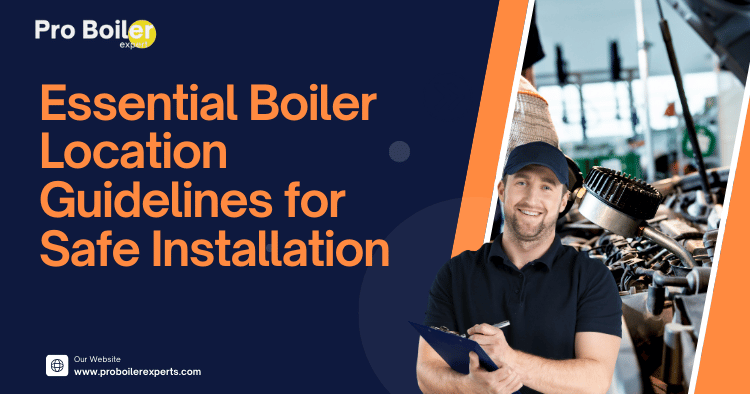Table of Contents
- Introduction
- Understanding Boiler Types
- Choosing the Right Location
- Safety Considerations
- Regulatory Compliance
- FAQs
- Conclusion
Introduction
Installing a boiler is a crucial step in ensuring your home stays warm and comfortable during colder months. However, selecting the right location for your boiler is just as important as the installation itself. In this article, we’ll explore essential boiler location guidelines to help you make informed decisions that prioritize safety and efficiency.
Understanding Boiler Types
Before diving into location guidelines, it’s essential to understand the different types of boilers available. The most common types are:
- Combi Boilers: These compact units heat water directly from the mains supply, eliminating the need for a separate hot water cylinder. Learn more about the top 5 benefits of choosing combi boilers for your home.
- System Boilers: These require a hot water cylinder but can provide a constant supply of hot water without the need for a water tank in the loft. Explore the top 5 benefits of choosing a system boiler for your home.
- Regular Boilers: Often found in older homes, these systems consist of a boiler, a hot water cylinder, and a cold water tank. For insights on traditional setups, read about the top 5 benefits of conventional boilers for your home.
Table of Boiler Types
| Boiler Type | Description | Ideal Location |
|---|---|---|
| Combi | Instant hot water, no tank required | Kitchen, cupboard, or loft |
| System | Requires a hot water cylinder | Utility room or airing cupboard |
| Regular | Traditional setup, requires tanks | Loft or utility room |
Understanding these types will help you choose the right installation location based on space and accessibility.
Choosing the Right Location
When selecting a boiler location, consider the following factors:
Accessibility
Your boiler should be easily accessible for maintenance and repairs. Avoid placing it in cramped spaces or areas that are difficult to reach. A utility room or a dedicated boiler cupboard is often ideal.
“Accessibility is key! A well-placed boiler can save you time and money on maintenance.”
Ventilation
Proper ventilation is crucial for efficient boiler operation. Ensure there is adequate airflow around the boiler to prevent overheating. If the boiler is in a closed space, consider installing vents or a fan.
“Good ventilation is not just about comfort; it’s a safety requirement!”
Proximity to Services
Place your boiler near existing gas, water, and electricity supplies to minimize installation costs and ensure efficiency. You can learn more about the efficiency of different boiler types in our articles on gas boilers and electric boilers.
Noise Considerations
Boilers can be noisy, especially during operation. Avoid placing them near bedrooms or living areas where noise might be disruptive. Consider checking out our guide on the top 5 quiet boilers for peaceful home comfort.
“Remember, a quiet boiler makes for a peaceful home!”
Safety Considerations
Safety is paramount when installing a boiler. Here are some key considerations:
Clearances
Maintain appropriate clearances around the boiler. Most manufacturers recommend a minimum distance of 300mm from walls and other appliances for safe operation and maintenance.
Carbon Monoxide Detection
Install a carbon monoxide detector near the boiler location. This will alert you to any potential gas leaks, ensuring safety for you and your family.
“A carbon monoxide detector could save lives—never skip this step!”
Flue and Ventilation Requirements
Ensure the boiler flue is installed correctly to prevent harmful gases from entering your home. Follow the manufacturer’s instructions and local regulations for vent installation.
Fire Safety
Keep flammable materials away from the boiler. Follow fire safety guidelines, including having a fire extinguisher nearby if necessary.
Regulatory Compliance
Before you install your boiler, it’s essential to comply with local regulations. Here are some key points to consider:
Building Regulations
Most areas have building codes that govern boiler installations. Check with your local council or building authority to ensure compliance. For more information on UK regulations, visit Gov.uk.
Gas Safe Register
If you’re working with gas boilers, ensure your installer is registered with the Gas Safe Register. This ensures that the installation meets safety standards. You can find more about safety regulations in our article about gas safety regulations for boiler installation.
“Always verify your installer’s credentials—safety first!”
Regular Inspections
After installation, schedule regular inspections and maintenance with a qualified technician to ensure everything remains compliant and safe.
FAQs
What is the best location for a boiler?
The best location is a well-ventilated area that is easily accessible for maintenance, such as a utility room or a dedicated boiler cupboard.
Can I install a boiler in a bathroom?
While it’s possible, it’s generally not recommended due to moisture concerns. Check local regulations for specific guidelines.
How far should a boiler be from walls?
Most manufacturers recommend a minimum clearance of 300mm from any walls or other appliances.
Do I need permission to install a boiler?
Yes, you typically need to comply with local building regulations and obtain any necessary permits.
Conclusion
Choosing the right location for your boiler is crucial for both safety and efficiency. By following these essential boiler location guidelines, you’ll ensure a safe installation that keeps your home warm and comfortable. Remember to consult professionals when necessary and stay informed about local regulations. For further reading, check out the HSE Boiler Safety Guidelines.
“Your home comfort is worth the effort—make the right choices for your boiler installation!”
If you have any questions or need assistance, feel free to reach out to a certified boiler installer or contractor. Stay warm and safe!





